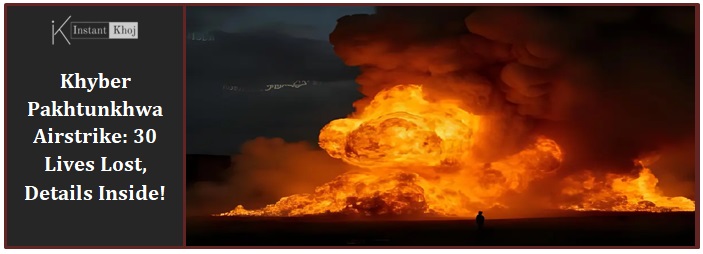Introduction
On September 22, 2025, the serene yet volatile Tirah Valley in Khyber Pakhtunkhwa (KP), Pakistan was shaken by a devastating airstrike carried out by the Pakistan Air Force. The attack targeted a compound allegedly used by militants from the banned organization Tehrik-e-Taliban Pakistan (TTP), resulting in the loss of at least 30 lives, many of whom were civilians, including women and children. This tragic incident once again highlights the grim reality faced by the region — the constant struggle to maintain security amid persistent militant threats while trying to safeguard innocent lives.
This article provides a comprehensive exploration of the incident, shedding light on the background of militancy in KP, the humanitarian fallout, governmental responses, regional security dynamics, international concerns, and the broader implications of the tragedy.
Details of the Incident: What Transpired in Tirah Valley?
In the early hours of September 22, at approximately 2 a.m., Pakistani fighter jets conducted a precision airstrike in Matre Dara village, nestled in the rugged terrain of Tirah Valley. The air force dropped eight LS-6 bombs on a compound identified as a stronghold for TTP militants. The aftermath was catastrophic— the explosion obliterated the compound and caused extensive damage to adjacent homes, leaving many structures reduced to rubble.
Rescue operations that followed discovered 30 bodies, many of them civilians caught amidst the chaos — women and children tragically among the deceased. The situation remains fluid as rescue teams continue to search for survivors or additional casualties buried under debris. There are fears that the death toll might increase as more victims are unearthed.
Authorities have stated that the target was a known militant hideout, suspected to house local commanders Aman Gul and Masood Khan, involved in planning and executing attacks against security forces and civilians in the region.
Background of the Targeted Compound and the TTP Militant Threat
Understanding the broader context requires examining the nature of the Tehrik-e-Taliban Pakistan (TTP) and its influence in Khyber Pakhtunkhwa. Established in 2007, the TTP is a militant group banned in Pakistan and internationally recognized as a terrorist organization. The group seeks to impose its strict interpretation of Sharia law across Pakistan and has been responsible for hundreds of deadly attacks on military personnel, civilians, and government infrastructure.
The compound targeted by the airstrike reportedly served as a bomb-making facility, a critical operational hub for the militants. Reports also suggest the militants have been using civilian homes and mosques as shields, complicating efforts to isolate and strike them without harming innocent residents. This tactic not only jeopardizes civilian safety but also challenges the military’s precision and intelligence capabilities.
The group’s resurgence has been linked to the shifting political landscape in neighboring Afghanistan. Since the Taliban’s return to power in 2021, militants like the TTP have found sanctuary across the porous Afghanistan-Pakistan border, allowing them to regroup, rearm, and launch cross-border attacks. This ongoing dynamic contributes to Pakistan’s intensified military focus on the region, including frequent air and ground operations aimed at eradicating militant nests.
Civilian Impact and Growing Humanitarian Concerns
The loss of innocent civilian lives remains the most tragic element of this event. Airstrikes in areas with dense civilian populations inherently carry the risk of collateral damage, despite the military’s efforts to conduct targeted operations.
Local communities, human rights organizations, and observers have voiced serious concerns regarding the protection of non-combatants. The death of women and children in the strike underscores the difficulty of completely avoiding civilian casualties in such conflict zones.
Moreover, the humanitarian fallout is profound. Survivors face immediate challenges, including:
-
Loss of shelter and livelihood as homes are destroyed.
-
Psychological trauma from the violence and loss of family members.
-
Displacement as families flee insecure areas.
-
Limited access to medical aid due to the remote and rugged terrain.
Humanitarian groups emphasize the need for the Pakistani government and military to implement stronger safeguards, including better intelligence, enhanced precision in targeting, and more robust efforts to evacuate civilians prior to operations.
Government and Military Response: Balancing Security and Accountability
The Pakistani government, through the Inter-Services Public Relations (ISPR), officially confirmed the airstrike as part of its ongoing counterterrorism campaign in KP. They described the operation as a necessary strike against a high-value militant target responsible for terror activities in the region.
While defending the legitimacy of the operation, the military acknowledged the civilian casualties and promised a thorough investigation into the incident. Officials have expressed regret over the loss of innocent lives and pledged to take measures to avoid such outcomes in future missions.
This tragedy has sparked intense domestic debate about the balance between Pakistan’s security imperatives and the protection of its civilian population. Opposition parties and civil society activists have called for greater transparency and accountability regarding military operations and civilian harm.
Regional Security Context: Militancy and Military Operations in Khyber Pakhtunkhwa
The airstrike is part of a broader trend of increased military operations across KP and adjoining tribal districts such as Bajaur and North Waziristan, which have seen a resurgence of militant activity in recent years.
Several factors contribute to this complex security environment:
-
Challenging geography: The mountainous terrain provides militants with natural hideouts, complicating ground operations.
-
Porous borders: The Afghanistan-Pakistan border remains difficult to monitor, allowing militants to move freely.
-
Safe havens: The Taliban-controlled Afghan areas serve as sanctuaries for groups like the TTP.
-
Local support networks: Some tribal communities have complex relationships with militant groups, ranging from coercion to complicity.
Pakistan’s response has included a combination of airstrikes, ground offensives, and intelligence operations aimed at dismantling militant infrastructure. However, these efforts are continually challenged by the militants’ tactics, including embedding within civilian populations, which increases risks to innocent people.
International Reactions: Human Rights and Global Perspectives
International human rights organizations such as Amnesty International and Human Rights Watch have condemned the rising civilian casualties in military operations in Pakistan’s northwest. While recognizing Pakistan’s right to combat terrorism, they have urged adherence to international humanitarian law, emphasizing the principles of distinction and proportionality to prevent harm to civilians.
Global governments and multilateral bodies have called for increased transparency, accountability, and cooperation to address the root causes of militancy while ensuring respect for human rights.
Broader Implications: The Need for a Comprehensive Approach
The tragedy in Tirah Valley encapsulates the difficult dilemma faced by Pakistan and many countries dealing with insurgencies: how to effectively neutralize militant threats without sacrificing civilian safety.
Key lessons and implications include:
-
Improved Intelligence and Precision: Investing in advanced surveillance and precision weaponry to minimize collateral damage.
-
Civilian Protection Measures: Developing robust protocols to evacuate civilians before strikes.
-
Addressing Militancy’s Roots: Beyond military action, tackling socio-economic deprivation, lack of education, and political marginalization that fuel militancy.
-
Post-Strike Humanitarian Aid: Ensuring prompt medical, psychological, and rebuilding support for affected communities.
Conclusion
The September 22, 2025, airstrike in Khyber Pakhtunkhwa resulting in the death of 30 people is a sobering reminder of the human cost of conflict in Pakistan’s northwest. It highlights the ongoing security challenges posed by militant groups like the TTP and the difficult balance the Pakistani military must strike between neutralizing threats and protecting civilian lives.
Moving forward, Pakistan must pursue more precise and humane counterterrorism strategies while investing in long-term solutions that promote development, governance, and peace. Humanitarian assistance to affected communities must be prioritized to help survivors recover and rebuild.
This tragic event serves as a call to all stakeholders—government, military, civil society, and the international community—to collaborate in fostering stability and ensuring that the sanctity of human life remains central to efforts to secure Khyber Pakhtunkhwa and the broader region.
Also Read:
Deadly Jerusalem Bus Attack Shakes City, People Demand Answers
FollowCurrent AffairsonInstantkhoj for more latest stories and trending topics.




